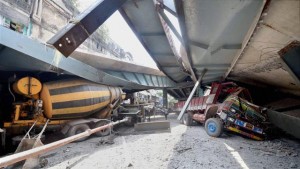Every time, there is a disaster, natural or manmade, we ask ourselves whether we have learned any lesson, whether casualty/injury could be minimized, how long it took for adequate relief to reach, minutes, hours, or days? Have standard operating procedures been developed for flyovers, bridges, and other heavy construction in crowded places? Where do I download the guideline from and whether it will be enforced by every urban development authority? Can Urban development ministry and National Disaster Management Authority start work on it? Can all municipal corporations which have such work going on can also start the process of codification and disaster preparation so that we know where are the cranes, hammers, crossbar, etc.,
I wrote about it after 2001 earthquake ( sristi.org/dmis), after Uttrakhand disasters and wish to reiterate it after bridge collapse in Kolkata. It is obvious that in almost every such disaster, first line of defense is the local community. Is there any harm in organising a basic training in rescue, relief and Rehabilitation (RRR) before starting any major bridge/flyover/tower construction say above 50 crores in public place? This is particularly true in crowded places. There is a need for a national database of all tools and equipment required for RRR in each district, municipal ward and address and numbers of larger cranes/cutters etc., with in 50 km range.
It took more than two to three hours before any major help reached the site in Kolkata. People were climbing all over the places with the best intentions, not knowing, a extra slight load at which point might crush people underneath beyond tolerable limit. Good intentions are not enough. Commitment to help must be accompanied by competent advice. Just as we had homegurads, can we think of Volunteers for relief in Disaster( VlounteeRd), trained every six months by NDMA and its affiliates. There can be a law that even private cranes and other such life-saving equipment can be requisitioned for emergency relief on a due compensation basis. The contractor should also be liable for some of the damages if his negligence is proved. We learned that gas cutter can cut through bodies underneath, so different kinds of cutters were needed. The poor vendors, workers, and others who died underneath, must not die again through our unwillingness to learn right lessons from this disaster. The heart wrenching scene described an onlooker when a firefighter could not save a driver of a cab trapped in the tangle of concrete and rods tell everything.
Can we analyse all the data about the accident in this case and also all other flyover accident/bridge cases, try to search for a pattern and draw some lessons. Then the design process of such bridges may improve, the teaching of construction science may improve too and hopefully accident rate comes down, casualty rate comes down completely.
Lest readers feel that this expectation is too much; look at the Japanese example where earthquake frequently take place, bridges do crack but seldom do we have casualty at this rate. Indian aspirations for a develop nation future cannot be fulfilled if we don’t improve our system of a) documentation and analysis of disasters, b) drawing lessons from them, c) doing pattern analysis, d) developing guidelines or revising existing guidelines, e) developing new standards and f) incorporating these in educational materials.
I am earnestly hoping that NITI Aayog and NDMA will take lead in ensuring that lives lost in this disaster don’t go waste.
 (Photo: http://www.hindustantimes.com/india/under-construction-flyover-collapses-in-kolkata-casualties-feared/story-vWTWBzpprEqUBDiLYPZtPL.html)
(Photo: http://www.hindustantimes.com/india/under-construction-flyover-collapses-in-kolkata-casualties-feared/story-vWTWBzpprEqUBDiLYPZtPL.html)

(Photo: http://www.livemint.com/Opinion/p3evcwgtzklcctqJYEhrbL/Kolkata-flyover-collapse-A-disaster-that-was-waiting-to-hap.html)
